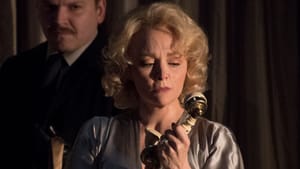Stay in the Loop
BSR publishes on a weekly schedule, with an email newsletter every Wednesday and Thursday morning. There’s no paywall, and subscribing is always free.
Dial down the design
Resident Ensemble Players present Frederick Knott's 'Dial M for Murder'

Frederick Knott’s 1952 thriller Dial ‘M’ for Murder was a huge hit, adapted by Alfred Hitchcock for film two years after it debuted. As a period piece that was once the epitome of the onstage thriller, it holds up well in director Steve Tague’s revival for the Resident Ensemble Players (REP), the University of Delaware’s resident company. However, it’s less successful when the production’s overstated music and light effects threaten to knock us out of the story.
Despite the title, the big, old-fashioned hardwired desk phone isn’t a major factor in the plot. Greed, of course, is, along with the tiny details that make a satisfying detective story, from Sherlock Holmes to, well, Sherlock Holmes.
Londoner Tony Wendice (Michael Gotch) is married to Margo (Elizabeth Heflin), who had a dalliance with American mystery writer Max (Lee E. Ernst). Margo and Max don’t know that Tony knows; they also don’t know that Tony has concocted an elaborate scheme to kill Margo for her money.
Every little detail
Knott went on to write Wait Until Dark, which REP featured last season and Hedgerow Theatre produces February 8 through March 13, 2018. The 1966 thriller introduces a dynamic heroine, a blind woman who ingeniously thwarts several attackers.
Here, Margo’s a typically helpless and flighty 1950s lead, despite Heflin’s fine efforts. The play builds skillfully as Tony conjures one set of lies to get Margo and Max out of the way, then blackmails old college friend Lesgate (Mic Matarrese) into killing Margo in a foolproof plan.
“The perfect murder,” Max explains, is easy to create in stories, because “the author makes things turn out exactly as he wants them to.” Real life — and exciting drama — is more complicated. When Tony’s play goes awry, he improvises, and Inspector Hubbard (Stephen Pelinski) arrests Margo for murdering her would-be assassin.
The story jumps ahead several months to Margo’s impending execution (no long death-row appeals in Britain back then) and some ironic twists as Hubbard explores hunches while time runs out. The resolution hinges on those little details for which no criminal can completely account. The final few minutes sizzle with tension.
Designs: Enough and too much
REP again employs filmic underscoring to enhance a thriller, as it did with Wait Until Dark, though with a different director and sound designer. Lindsay Jones’s suspense-enhancing compositions perfectly match the stage action, but unlike in a film, it’s distracting because of that perfection. We marvel at the skill, which takes us out of the story.
It also feels indulgent and condescending, as if we need music to direct our emotions. In a stage thriller, when we’re trying to follow the plot’s details, it’s downright intrusive. The music works best as a subtle throbbing beat under the Inspector’s urgent questioning, rather than more typical, broadly suspenseful melodies.
Matthew Richards’s lighting features bold streaks and sharp shadows but often changes radically, becoming as distracting as the music and overstating what we should feel. One can’t help but wonder why the characters don’t notice the wild fluctuations and call the power company.
Meanwhile, Stefanie Hansen’s spacious London apartment is appropriately gorgeous and luxurious, and Andrea Barrier dresses all with period accuracy.
Knott (1916–2002) only wrote three murder mysteries; 1961’s Write Me a Murder, while less known, was also a hit. These old thrillers are still gripping: no heavy-handed designs required.
What, When, Where
Dial ‘M’ for Murder. By Frederick Knott, Steve Tague direcgted. Resident Ensemble Players. Through February 4, 2018, by the University of Delaware's Roselle Center for the Arts, 110 Orchard Road, Newark, Delaware. (302) 831-2204 or rep.udel.edu.
Sign up for our newsletter
All of the week's new articles, all in one place. Sign up for the free weekly BSR newsletters, and don't miss a conversation.

 Mark Cofta
Mark Cofta